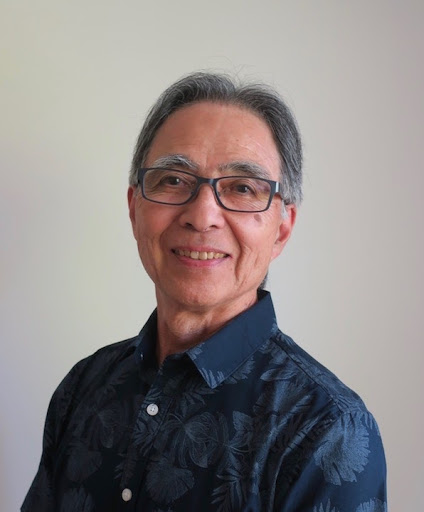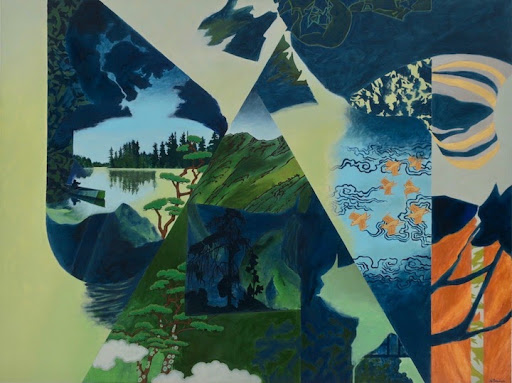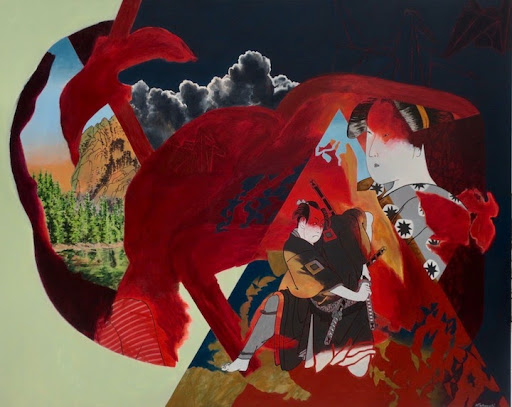It took Ottawa-based painter Norman Takeuchi most of his life to come to terms with his Japanese heritage.
In 1942, his family was uprooted from their home on the coast of Vancouver to a small community in the interior of the city where the Canadian government had designated for them to live during the internment years of the Second World War.
The traumatic experience caused Takeuchi to distance himself from his ethnicity both in his life and art. His work, up until recent years, featured no hints of his past.
“We were labeled enemy aliens, even though many of us were Canadian citizens and born in Canada,” said Takeuchi. “So there was that feeling of shame.”
“This is what stuck with me for many years, and I did not want to be Japanese, I did not want to accept the fact that that’s what I was. And so for years, I just looked upon myself as a Canadian, and in my artwork I was a Canadian painter.”

It wasn’t until he saw an exhibition of kimonos by Japanese textile artist Itchiku Kubota at the Museum of Civilization and found himself astonished by its beauty that Takeuchi began to take pride in his heritage.
“We always had this negative feeling about Japan, and what they did during the war, even though most of us couldn’t even speak Japanese and knew very little about the culture, there’s always that link and a feeling that somehow we were also implicated,” he said.
“For the first time, I started to think about Japan and that there are good things coming from there.”

His abstract works still work with shape, but they now include Canadian iconography like Western mountain ranges and homages to Tom Thomson alongside Japanese woodblock prints and imagery like cherry blossoms and iconic kimono patterns.
Other paintings feature iconography from the internment years–such as the blankets women hung up to create privacy in a livestock building in Vancouver to create privacy between the thousands of Japanese Canadians forced to live there.
“In doing that, I think it really helped me to realize that I am who I am and there’s no reason to feel this kind of shame,” he said, adding that when he started to feel more comfortable with his heritage, the elements of his paintings seemed more harmonious. The colours were brighter, and the images weren’t as harsh and disjointed.
“I think, generally, people responded better to those pieces as well.”
The subject matter of Takeuchi’s art has spoken to other marginalized Canadians, according to his wife, Marion. After being married for 53 years, Takeuchi said his wife is also his financial advisor, archivist and occasional critic.
For the first time, I started to think about Japan and that there are good things coming from there.
When an exhibit featuring his work travelled to a community north of Winnipeg, Marion said her husband was in contact with a woman who described the impact of his work on Indigenous children in the community.
“They saw it wasn’t just them that are being discriminated against, but that it happens to other groups,” Marion said.
And while much of his work focuses on celebrating his cultural background, Takeuchi’s love of painting remains the main motivator in his career.
“I don’t want to do anything else,” Takeuchi said. “I can’t help myself, it’s something that I have to do. And I can’t explain it in any other way.”
“Norman has what fulfils him,” Marion said, knowingly.

“For years now, the Japanese community has sort of come together and accepted who we are,” he said. “There’s been all kinds of words put together and images made about what the Japanese went through, and I want to add my voice to that.”
“I want to be part of these people who are saying this is what happened to us, and hopefully it will not happen again.”
Featured image provided by Norman Takeuchi.






